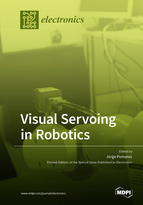Visual Servoing in Robotics
A special issue of Electronics (ISSN 2079-9292). This special issue belongs to the section "Systems & Control Engineering".
Deadline for manuscript submissions: closed (30 June 2019) | Viewed by 42783
Special Issue Editor
Interests: visual servoing; robot control; space robotics
Special Issues, Collections and Topics in MDPI journals
Special Issue Information
Dear Colleagues,
Visual servoing is a well-known approach to guide robots using visual information. Image processing, robotics and control theory are combined in order to control the motion of a robot depending on the visual information extracted from the images captures by one or several cameras. With respect to vision issues, different problems are currently under research such as the use of different kind of image features (or different kind of cameras), image processing at high velocity, convergence properties, etc. Furthermore, the use of new control schemes allows the system to behave more robustly. Related issues such as optimal and robust approaches, direct control, path tracking or sensor fusion allows the application of the visual servoing systems in different domains.
This Special Issue aims to cover the most recent advances in visual servoing including industrial and service robotics. Novel theoretical approaches or practical applications of all aspects of visual servoing systems are welcomed. Reviews and surveys of the state-of-the-art are also welcomed. Topics of interest to this Special Issue include, but are not limited to, the following topics:
- Path-planning in visual servoing
- Navigation and localization using visual servoing
- Dynamic and direct visual control of robotic systems
- Robust and optimal control of robots
- Intelligent control
- Deep learning and machine learning in visual servoing
- Intelligent transportation using visual servoing
- Non-linear visual control of robotics systems
- Visual servoing in manipulation tasks
- Visual servoing in field robotics
- Space robotics and visual servoing
- Real-time embedded visual control systems
- Humanoid robots and visual servoing
Dr. Jorge Pomares
Guest Editor
Manuscript Submission Information
Manuscripts should be submitted online at www.mdpi.com by registering and logging in to this website. Once you are registered, click here to go to the submission form. Manuscripts can be submitted until the deadline. All submissions that pass pre-check are peer-reviewed. Accepted papers will be published continuously in the journal (as soon as accepted) and will be listed together on the special issue website. Research articles, review articles as well as short communications are invited. For planned papers, a title and short abstract (about 100 words) can be sent to the Editorial Office for announcement on this website.
Submitted manuscripts should not have been published previously, nor be under consideration for publication elsewhere (except conference proceedings papers). All manuscripts are thoroughly refereed through a single-blind peer-review process. A guide for authors and other relevant information for submission of manuscripts is available on the Instructions for Authors page. Electronics is an international peer-reviewed open access semimonthly journal published by MDPI.
Please visit the Instructions for Authors page before submitting a manuscript. The Article Processing Charge (APC) for publication in this open access journal is 2400 CHF (Swiss Francs). Submitted papers should be well formatted and use good English. Authors may use MDPI's English editing service prior to publication or during author revisions.
Keywords
- Path-planning in visual servoing
- Navigation and localization using visual servoing
- Dynamic and direct visual control of robotic systems
- Robust and optimal control of robots
- Deep learning and machine learning in visual servoing
- Non-linear visual control of robotics systems
- Visual servoing in manipulation taks
- Visual servoing in field robotics
- Space robotics and visual servoing
- Real-time embedded visual control systems
- Humanoid robots and visual servoing






